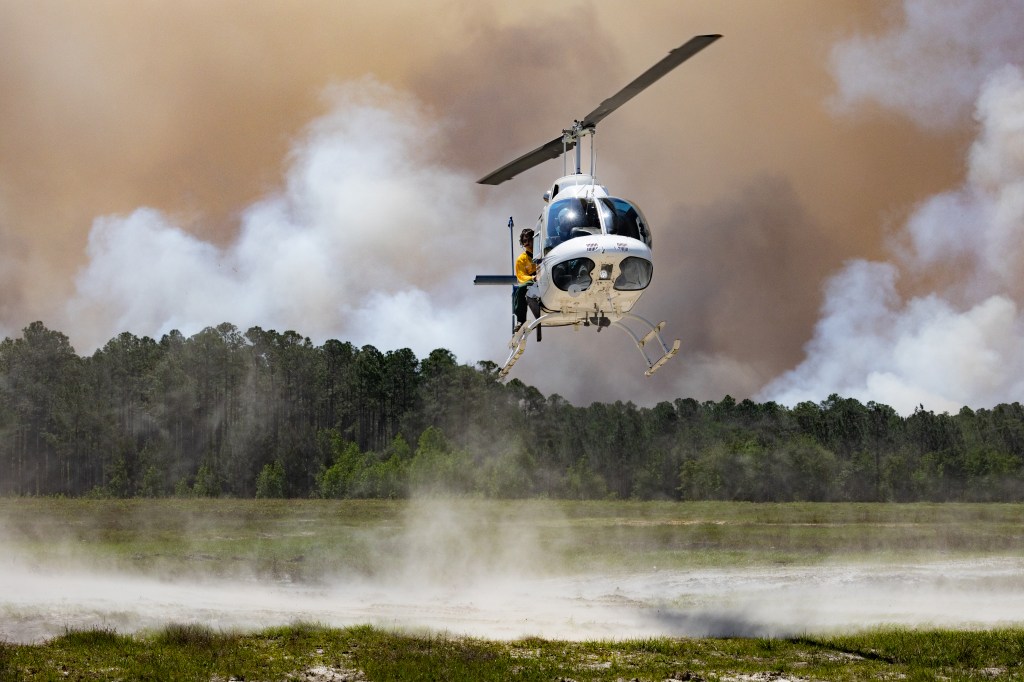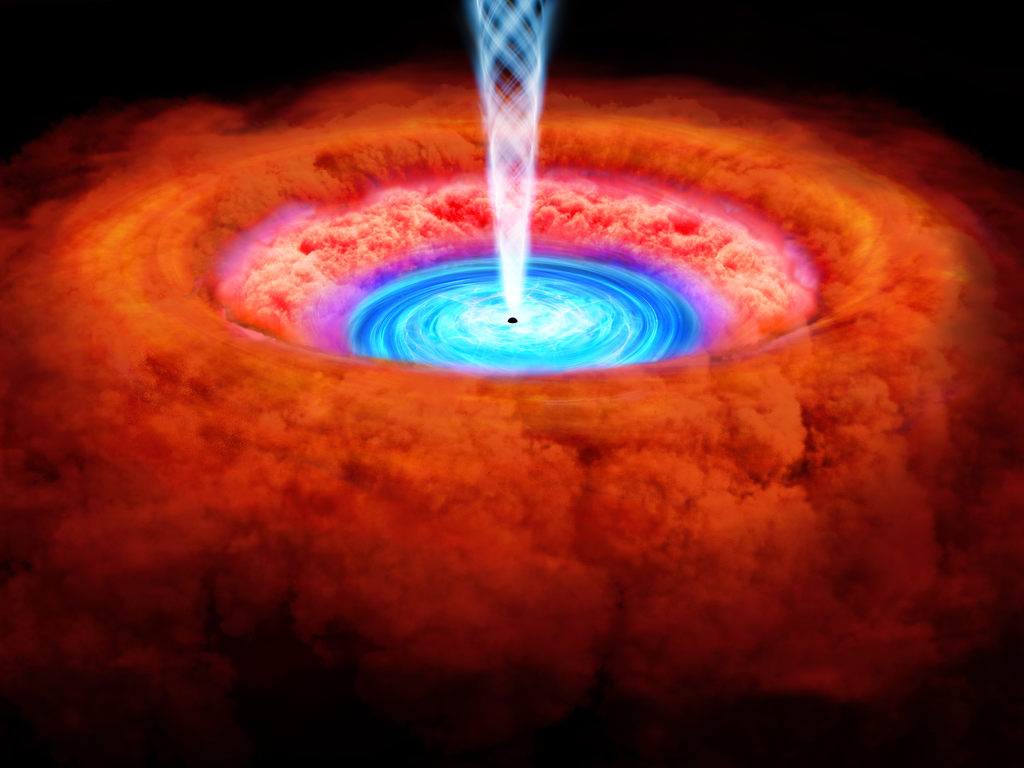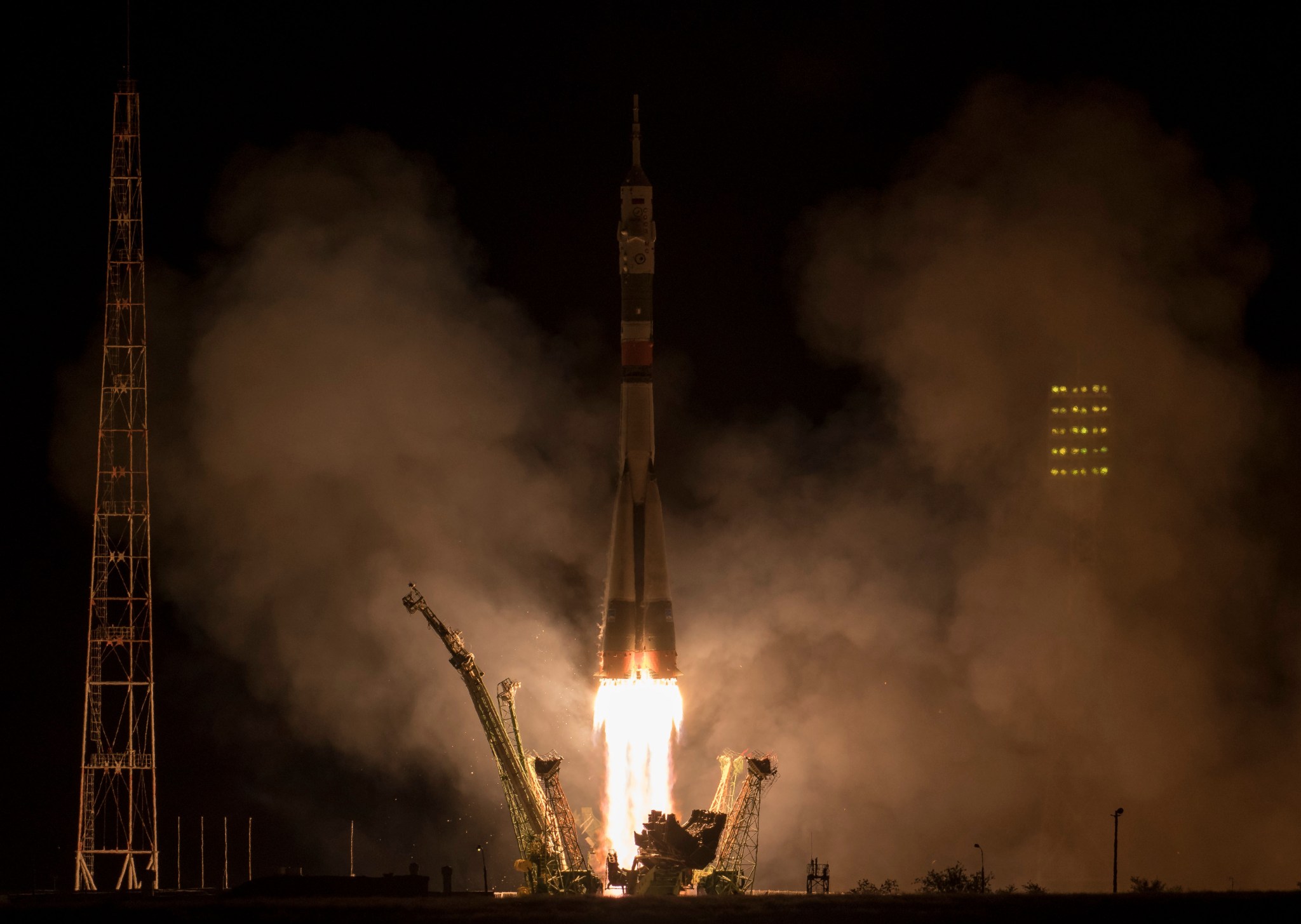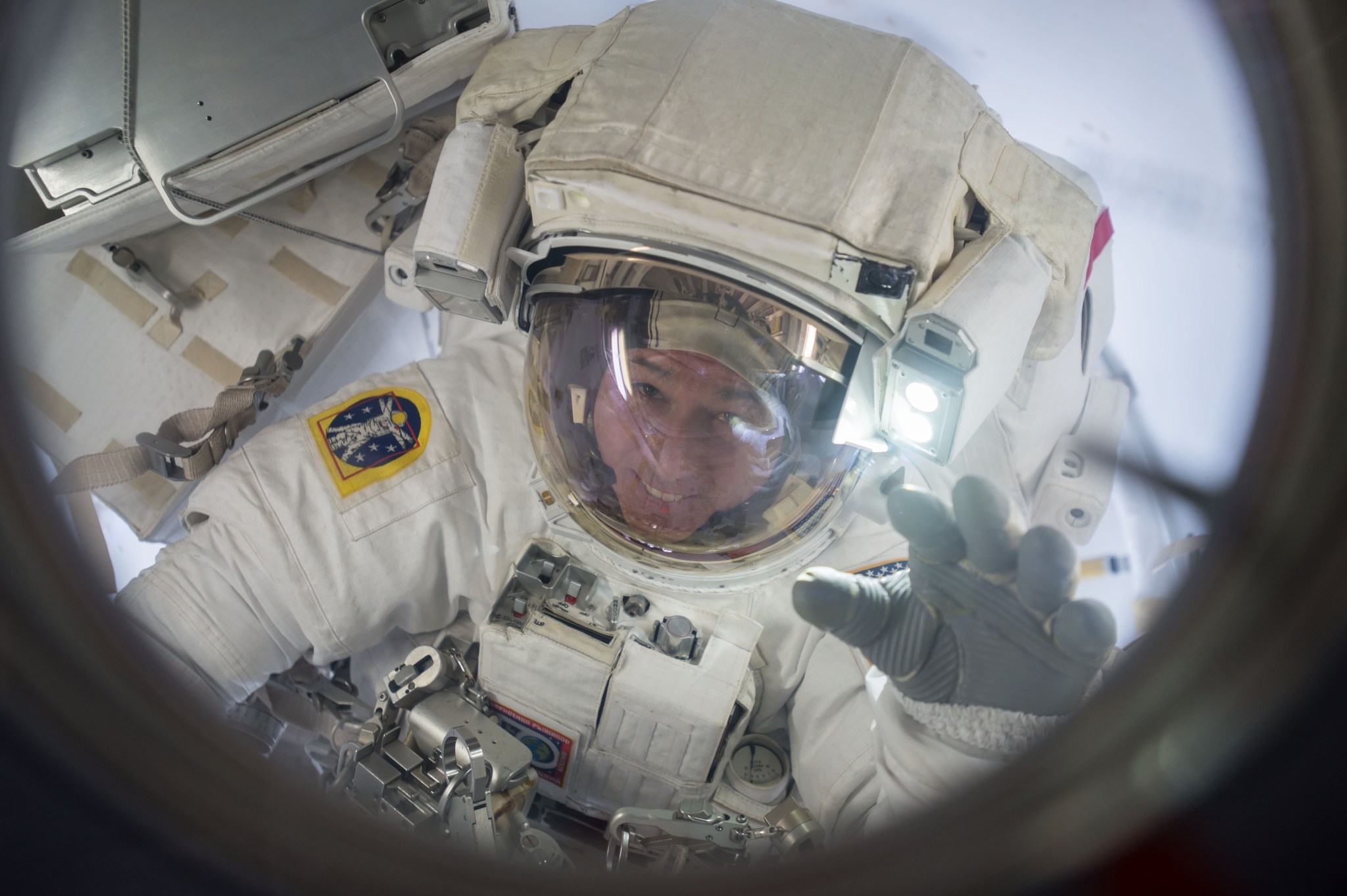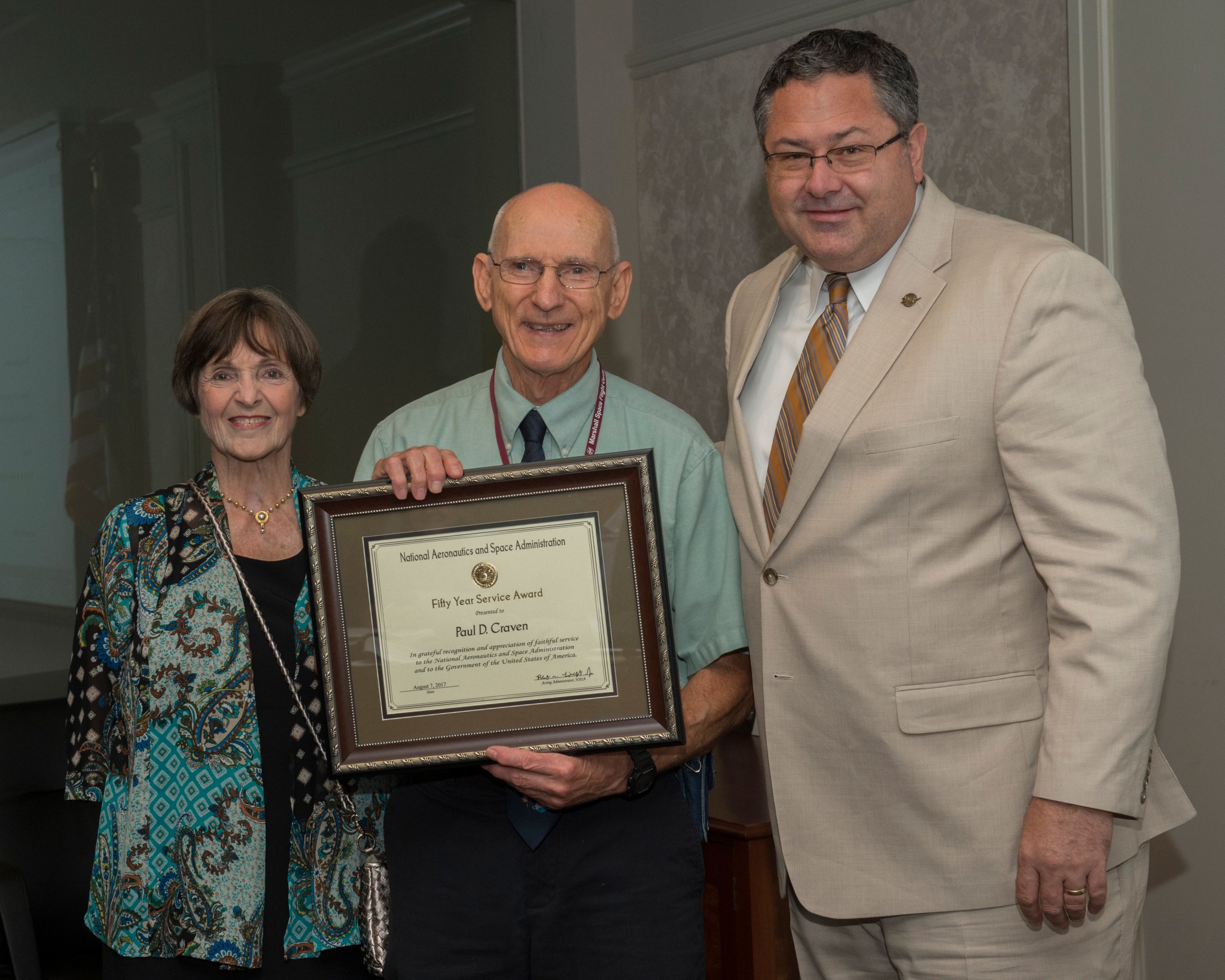In This Week’s Star
- Director’s Corner: Only as Strong as its People
- Three New Crew Members Arrive at International Space Station
- NASA Completes Welding of Liquid Oxygen Tank for First SLS Flight
- NASA Astronaut Shane Kimbrough to Visit Marshall on Sept. 19-20
- After 50 Years at Marshall, Paul Craven Still Eager to Learn
- Safety Week 2017: We Learn from Mistakes as Well as Successes
- This Week in NASA History: Spacelab-J Launches – Sept. 12, 1992
- Obituaries
Director’s Corner: Only as Strong as its People
In my last column, I talked about the concept of bimodal operations as a promising approach to seek out new opportunities for Marshall to support NASA’s missions, while effectively managing our current commitments. Bimodal operations, like SharePoint or a PMP certification, are simply tools for the center’s workforce — the true benefits are tied to each person.
If an organization could be represented as a geometric figure, it would be a fractal. Fractals are structures that are made of the same recurring pattern, and look the same at every scale — from microscopic, to macroscopic, to systemic. Examples of fractals in nature include strands of DNA, seashells, and the edges of Saturn’s rings. If you haven’t gone down the Google rabbit hole looking at fractals, it’s worth a few minutes of your time.
An organization like Marshall is a fractal composed of people – and at every scale, the pattern is elegantly duplicated. The pattern can be reduced to the individual, expanded to each office, and when viewed as a whole, the center is fundamentally the team. This is why people are a huge focus of our plan to thrive. Marshall not only needs the right men and women for each position, but an environment that encourages professional self-development and growth, a positive work-life balance and clarity of purpose.
The leadership team is working to strengthen these areas of focus, including the center-wide mentoring initiative that Deputy Director Jody Singer is leading. Mentoring activities, such as the recent Pay it Forward event at the U.S. Space and Rocket Center Education Training Facility, are a terrific opportunity to not only learn from other team members, but to share your own knowledge and insights as a mentor yourself. So, take a moment and check out the Marshall Mentoring site on ExplorNet. You can sign up to be a mentor or mentee, as well as RSVP for future mentoring events.
Beyond the resources offered at Marshall, professional associations are also a great way to pursue new avenues for professional development, or just expand your peer-to-peer network. Next month, the American Astronautical Society will hold its annual Wernher von Braun Memorial Symposium, which always brings together thought leaders from all over the world, right here in Huntsville, to discuss science, policy and other issues pertinent to NASA and Marshall. The global space community looks to Marshall for leadership, and this event gives us a true platform for it.
The Greater Huntsville Section of American Institute for Aeronautics and Astronautics is hosting its second annual YP Symposium just prior to the von Braun Symposium, providing young professionals an opportunity to network and grow their careers. I know many of you already plan to participate in one or both of these events, but if you weren’t planning to attend, it’s a great example of the benefits of membership with associations like AAS and AIAA.
The bottom line is that Marshall is only as strong as its people. Without you, this place is just a campus — a collection of buildings. People give life to great ideas: Not the other way around. And when the stakes are as high as getting America’s next-generation rocket built, tested and ready for its first mission; or ensuring an international crew in an orbiting laboratory can safely and successfully conduct critical science experiments; or turn an astrophysics mission proposal into a real space-based instrument; then it’s absolutely crucial that our team is positioned for success.
At last week’s all-hands meeting with Acting Administrator Robert Lightfoot and Acting Deputy Associate Administrator Lesa Roe, Robert said something that really resonated with me. It resonated because it underscored both the risk and reward of what we do at Marshall. He was asked a great question by one of our team members: “What keeps you up at night?” Robert responded by saying that he worries that we haven’t flown crews since shuttle. The launch pad is the spiritual symbol of the space program — it is by no means the sum of what this agency is…or does…but our history is rooted in exploration. The power and scale of human spaceflight and what it enables — including science, innovation and new discoveries — is our flag. And Marshall is on the leading edge of our nation’s return to the launch pad; NASA’s Space Launch System and Orion will enable the agency to fly again. So, we — the people who make Marshall and the agency what it is, regardless of where you sit or what you do — are the stewards of this purpose. What each of us does to grow as a professional or support the development of our peers, underwrites the future.
Three New Crew Members Arrive at International Space Station
After a six-hour flight, NASA astronauts Mark Vande Hei, Joe Acaba and Russian cosmonaut Alexander Misurkin arrived at the International Space Station at 9:55 p.m. CDT on Sept. 12, where they will continue important scientific research.
The three crewmates launched in a Soyuz spacecraft from the Baikonur Cosmodrome in Kazakhstan at 4:17 p.m., orbited Earth four times, and docked at the space station. The hatches between the spacecraft and station were opened at 12:08 a.m. on Sept. 13.
The arrival of Vande Hei, Acaba and Misurkin restores the station’s crew to six, as they join Expedition 53 Commander Randy Bresnik of NASA and Flight Engineers Sergey Ryazanskiy of Roscosmos and Paolo Nespoli of the European Space Agency. The new Expedition 53 crew members will spend more than four months conducting approximately 250 science investigations in fields such as biology, Earth science, human research, physical sciences and technology development.
Bresnik, Ryazanskiy and Nespoli are scheduled to remain aboard the station until December, and Vande Hei, Acaba and Misurkin are slated to return in February 2018.
This marks the first long-term increase in crew size on the U.S. segment from three to four, allowing NASA to maximize time dedicated to research. Highlights of upcoming investigations include demonstrating the benefits of manufacturing fiber optic filaments in a microgravity environment, a new study looking to slow or reverse muscle atrophy in astronauts during spaceflight and exploring the ability of a synthetic bone material that adheres bone to metal within minutes to accelerate bone repair.
The crew members also are scheduled to receive Orbital ATK’s next commercial resupply mission in November, delivering several tons of research, supplies and vehicle hardware.
For more than 16 years, humans have lived and worked continuously aboard the International Space Station, advancing scientific knowledge and demonstrating new technologies, making research breakthroughs not possible on Earth that will enable long-duration human and robotic exploration into deep space. A global endeavor, more than 200 people from 18 countries have visited the unique microgravity laboratory that has hosted more than 2,100 research investigations from researchers in more than 95 countries.
Follow Mark Vande Hei and Joe Acaba during their space mission in social media and get breaking news, images and features from the station on Instagram and Twitter.
NASA Completes Welding of Liquid Oxygen Tank for First SLS Flight

NASA is another step closer to completing all main structures of the core stage for the agency’s first launch of the Space Launch System deep-space rocket. The liquid oxygen flight tank was recently built in the Vertical Assembly Center robotic welder at NASA’s Michoud Assembly Facility. Five major parts — the engine section, liquid hydrogen tank, intertank, liquid oxygen tank and forward skirt — will be connected together to form the 212-foot-tall core stage, the backbone of the SLS rocket. Boeing, the prime contractor for the core stage, is currently welding the liquid hydrogen tank structure — the final major core stage structure to be built for the first integrated flight of SLS and NASA’s Orion spacecraft. The liquid hydrogen and liquid oxygen tanks will hold 733,000 gallons of propellant to power the stage’s four RS-25 engines that together produce more than 2 million pounds of thrust. (NASA/MSFC/Michoud/Jude Guidry)
NASA Astronaut Shane Kimbrough to Visit Marshall on Sept. 19-20
NASA astronaut Shane Kimbrough, who lived and worked six months on the International Space Station as commander of the orbiting laboratory, will visit NASA’s Marshall Space Flight Center Sept. 19-20. He will share highlights from his mission to space as part of the Expedition 49 and 50 crews.
During his stay on the station, Kimbrough conducted four spacewalks, during which he installed new batteries and relay boxes, and helped move a pressurized mating adapter for future spacecraft visiting the outpost. Kimbrough, a retired colonel in the U.S. Army, also contributed to hundreds of experiments in biology, biotechnology, physical science and Earth observations. For example, for the Microgravity Expanded Stem Cells investigation, Kimbrough and fellow crew members observed cell growth and other characteristics in microgravity. Results from this investigation could lead to the treatment of diseases and injury in space, and provide a way to improve stem cell production for medical therapies on Earth.
Selected for the NASA astronaut class of 2004, Kimbrough qualified for various technical assignments in the Astronaut Office at NASA’s Johnson Space Center before completing his first spaceflight in November 2008 as a crewmember of STS-126. The flight on the space shuttle Endeavor delivered a new bathroom, kitchen, two bedrooms, an exercise machine and a water recycling system to the space station.
Kimbrough will present mission highlights and take questions from the Marshall workforce at 2 p.m., Sept. 19 in Morris Auditorium, Building 4200. There will be a brief autograph session immediately following his remarks.
For more information about Kimbrough, click here, or visit his Twitter page.
After 50 Years at Marshall, Paul Craven Still Eager to Learn
By Jonathan Deal
Paul Craven has always been open to learning new things. In fact, it’s what has kept him going for the past 50 years at NASA’s Marshall Space Flight Center.
Craven, a physicist in the Materials and Processes Laboratory, recently received recognition for 50 years of service at the Marshall Center.
“I never thought I would be here for this long when I started,” said Craven. “It’s been fun and I have learned quite a bit. Any time I’m learning, I’m happy.”
Craven started working at Marshall in 1967 after earning his undergraduate degree in physics from the University of Alabama in Tuscaloosa. He would eventually earn his master’s and doctorate degrees in physics from the University of Alabama in Huntsville in 1993.
“At that point when I graduated college, I just wanted to go to work and the opportunity presented itself, so I came here to Marshall,” said Craven, a native of Warner Robins, Georgia.
One of his first memories of working for Marshall was on a work trip to Albany, New York, with a colleague. From there, they watched as Neil Armstrong took his first steps on the moon.
“Awesome. That’s about the best way to describe it,” said Craven. “At the time, we were just concentrating on what we were doing and had no idea the full significance of it.”
Craven soon began working in Marshall’s Space Sciences Lab on Skylab, America’s first orbiting space station, and continued working that project through its deployment from 1973-79. As NASA transitioned into the Space Shuttle Program, so did Craven, working on two different Spacelab missions – Spacelab 1 in 1983 and ATLAS-1 in 1992. Spacelab was a reusable laboratory used on certain spaceflights flown by the space shuttle.
Former Marshall Associate Director for Science, Rick Chappell, was the mission scientist for the Spacelab 1 mission and recalls working alongside Craven.
“Paul is a salt-of-the-Earth person in the sense that he worked hard, was very responsive, smart and connected to what we were doing — just an ideal team member,” said Chappell. “Paul is one of those who understands the science and can analyze the data and write papers that explain new knowledge that people have never understood before. Exploration is an adventure — not a job — and Paul is a great explorer.”
During Spacelab 1, Craven traveled to Johnson Space Center, working as an assistant mission scientist, but during ATLAS-I, mission science was based out of Marshall’s Payload Operations Control Center — now the Payload Operations Integration Center. He recalled working 12-hour shifts on console during those spacelab missions as an assistant mission scientist.
“Those missions were only seven to 11 days long, but being on console for 12 hours is tough. You come up with a plan for how you are going to do things and it changes as you go along,” said Craven about the ATLAS-I mission. “That was when they first started here with operations. Those were exciting times.”
Craven also worked on several unmanned missions during that time including the Retarding Ion Mass Spectrometer. Data from the project served as the thesis for Craven’s doctorate degree. Also known as RIMS, the purpose of the mission was to acquire data relevant to processes coupling the magnetosphere, ionosphere and upper atmosphere.
Following more than 30 years of work in the Space Sciences Lab, Craven moved to Marshall’s National Space Science & Technology Center in 2000. He remained there until 2007 when he began working in the Materials and Processes Laboratory, where he is a part of the Space Environmental Effects Team.
“The great thing about Paul is he is always willing to pitch in and help out,” said Mary Nehls, his team lead. “He can be a great organizer, but he can also get down into the technical aspects of it and help resolve any issues. He’s good across the board working on projects.”
One area where Craven excelled in the Space Environmental Effects lab is with the Lunar Environment Test System — the first and only operational test system available to examine the lunar surface environment.
“He is the name I associate with that system,” said Nehls. “Paul came in and made that whole system his own. That’s really what impresses me about Paul. His willingness to jump in and do whatever assignment needs to be done.”
Deal, an ASRC Federal/Analytical Services employee and the Marshall Star editor, supports the Office of Strategic Analysis & Communications.
Safety Week 2017: We Learn from Mistakes as Well as Successes
By Rick Smith
Schedule of Safety Week Events: “Learning Thursday,” Sept. 28
- Organizational Meetings — 9-10 a.m.
- “Mission Success is in Our Hands” Presentation: Fred Haise — 10-11:30 a.m.
- Organizational Meetings — 1-2 p.m.
- SATERN Safety Culture Training — 1-2 p.m.
- Presentation: SHE 106: Safety Visit Training for Supervisors — 1-3 p.m.
- Presentation: Medication Safety — 2-3 p.m.
- Dedicated Housekeeping — 2-3 p.m.
Editor’s Note: NASA’s Marshall Space Flight Center will mark Safety Week Sept. 25-29, with each day focused on a unique theme tied to team members’ health and well-being. The Marshall Star is presenting a series of articles on each day’s theme and the planned activities and presentations associated with it.
On Thursday, Sept. 28, Marshall’s Safety Week topic for the day will be “Learning,” embracing all the ways in which we absorb and apply the personal and professional lessons we learn. They may spring from something as complex as an on-the-job mishap — or as simple as an unmonitored microwave, according to Ela Washington, acting manager of the Training & Incentives Office in Marshall’s Office of Human Capital.
“More than 10 years ago, a burnt bag of microwave popcorn set off the fire alarm in a Marshall building,” she recalled. “There was no fire, but there was smoke galore. The building was evacuated, fire trucks rolled in and security came. I’m sure many team members working there remember it well — the scrutiny the incident received, discussions for mitigating future risk, new guidelines for microwave use in our break rooms.”
She smiled. “That kind of incident has not happened again in that building. As workers and human beings, we can learn from our mistakes, and from others’ mistakes as well.”
Anchoring activities on Sept. 28 is the “Mission Success is in Our Hands” discussion by former NASA astronaut Fred Haise Jr., who was part of the three-man Apollo 13 crew whose discipline and training were put to the test in April 1970 when an oxygen system failure threatened their mission and lives, forcing them to abort their planned moon landing. Aided by quick-thinking NASA teams back home, Haise, the lunar module pilot for Apollo 13, and fellow astronauts James Lovell and John Swigert converted their lunar module into a makeshift lifeboat and safely returned to Earth — an experience dramatized in the Oscar-winning 1995 film “Apollo 13.”
Haise will address the Marshall team at 10 a.m. Sept. 28 in Morris Auditorium in Building 4200. See ExplorNet for additional information.
From 1-3 p.m. in the Learning Lab on the ground floor of Building 4200, Brandi Thomas, a Bastion Technologies safety specialist supporting Marshall’s Safety and Mission Assurance Directorate, will teach a course titled “SHE 106: Safety Visit Training for Supervisors.” Hosted as part of Marshall’s Safety, Health and Environmental program, the class will aid civil service and contract supervisors and managers in successfully executing monthly SHE inspections of Marshall work areas, as required by Marshall Procedural Requirement 8715.1, and covers safety and health training for supervisors as required by the Occupational Safety and Health Administration.
Lisa Hall, an organization development specialist in Marshall’s Office of Human Capital and author of the 2009 self-help book “Taking Charge of Your Own Health,” will lead a presentation about “Medication Safety” from 2-3 p.m. in Building 4203, Room 1201. She will discuss the risks of mixing medications, taking the wrong pills and other concerns, offering tips to help individuals protect themselves. Learn more about Hall’s expertise here.
Washington, excited to have presentations on such diverse subjects, said an even broader training roster is available year-round through Marshall’s Training and Incentives Office. Training courses include leadership and management development; conflict resolution; and how to better identify and understand stormy weather. They are available in a classroom or via SATERN to help team members learn new tools for safer execution of duties, healthier lifestyles and greater personal success.
Team members also are reminded to visit SATERN to complete Safety Culture Training, and to set aside time for housekeeping in their offices, laboratories or shops. Washington hopes Marshall personnel will enthusiastically tackle these and all Safety Week actions and teaming events.
“I’ve heard this saying all my life: When we learn better, we do better,” she said. “It’s my goal to help team members live that credo every day — until the learning becomes second nature and further strengthens our safety culture.”
Safety Week is organized by the Safety and Mission Assurance Directorate. Team members are encouraged to monitor ExplorNet for Safety Week schedule updates.
Smith, an ASRC Federal/Analytical Services employee, supports the Office of Strategic Analysis & Communications.
This Week in NASA History: Spacelab-J Launches – Sept. 12, 1992

This week in 1992, space shuttle Endeavour and STS-47 launched from NASA’s Kennedy Space Center, beginning the 50th shuttle mission of the program. The mission carried a crewed Spacelab module, Spacelab-J, a joint venture between NASA and the National Space Development Agency of Japan, which conducted microgravity investigations in life and materials sciences. Today, the Payload Operations Integration Center at Marshall serves as “science central” for the space station, working 24/7, 365 days a year in support of the orbiting laboratory’s scientific experiments. The NASA History Program is responsible for generating, disseminating and preserving NASA’s remarkable history and providing a comprehensive understanding of the institutional, cultural, social, political, economic, technological and scientific aspects of NASA’s activities in aeronautics and space. For more pictures like this one and to connect to NASA’s history, visit the Marshall History Program’s webpage. (NASA)
Obituaries
James R. McGraw, 86, of Union Grove, Alabama, died Aug. 28. He retired from the Marshall Center in 1989 as a program analyst. He is survived by his wife, Doris C. McGraw.
Hillard R. Barkley, 97, of Huntsville, died Sept. 2. He retired from the Marshall Center in 1982 as a personnel management specialist.
Bernardine R. Jackson, 61, of Birmingham, Alabama, died Sept. 3. She retired from the Marshall Center in 2015 as a contract specialist.









